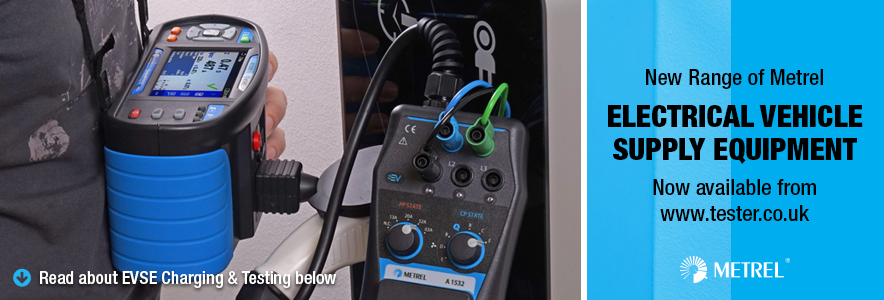With the Governments’ announcement to switch-over to electrical vehicles by 2040, the number of electric vehicle charging points (EVSE) is set to boom.
This week the Government published a league table of the best and worst regions in the UK to charge electric vehicles. It is plain to see that there is quite a lot of work on the horizon for installers of EVSE charging points over the next few years. Brendan Beaver, sales manager of Metrel UK, share’s his views with PASS about the future of testing such equipment and gives some useful tips on using the right instruments to get the job done!
“The change from diesel and petrol to electric vehicles is gathering pace. The government has posted the date of 2040 for the total switch-over, it’s put its money where its mouth is and decided to subsidise the installation of charging stations for homes. However, the scale of the task of installing charge points is mind-blowing.” says Brendan Beaver.
“At the end of 2016 there were 37.3 million registered vehicles in the UK, of which almost 31 million were cars. Assuming that the British are not going to surrender their mobility independence, and public transport will not experience a renaissance, there are an awful lot of charge points to be installed.”
In response to this challenge the 18th Edition of the Wiring Regulations has modified the requirements for “devices for fault connection by automatic disconnection of supply”, confirming that protective measures against DC fault current should be taken, unless it is provided by the charge point itself. This should consist of an “RCD type B or RCD type A and appropriate equipment that ensures disconnection of the supply in case of DC fault currents above 6 mA.”
There is no suggestion of a requirement or methodology to test the system, but how do you know it will work unless you have tested it? Whose neck is likely to be on the block if they haven’t tested it? After all, most of us have experienced brand new RCDs failing out of the box at some time.
So how do you test EVSE Chargers?
The ideal tool for testing this type of installation should be an installation or multi-function tester. However there needs to be some sort of adapter to connect the testers to the charge points. Manufacturers of the chargers sell such adapters but each is particular to their own design, trying to lock you in to their product. However, this could lock you out of future business when the chargers are ubiquitous and need inspection.
At present, there is only one adapter that can be used to test charge points of any manufacturer on the UK market, Metrel’s EVSE adapter A1532.
The major advantage is that the adapter accesses the charge point in the same manner as an electrical vehicle and thus tests the system as whole. It can test the charging point in all charging state outputs, disconnected, charge ready, active charging (with and without ventilation) and pilot error. As there is no need to open the box, testing is quick and there are no warranty implications.
The A1532 can be used with many installation testers; however, the most satisfactory results are with those testers that offer dedicated EVSE tests of which Type B RCD, Type EV RCD (30 mA AC and 6 mA DC) and RCM (Residual Current Monitoring) are the most significant. Metrel are leading the way as both their MI3125BT and the touch-screen MI3152 installation testers offer full testing and reporting functions for EV charge points.
With its full-colour touch-screen, the MI3152 stands out amongst its competitors. The high-resolution dot matrix display gives the operator clear and simple help screens should they forget the connection needed for a test, and unique to Metrel, it offers Auto Sequence® test procedures which take the installer through the required test regime, saving considerable time, and eliminating errors and omissions.
Watch these videos to see just how easy it is to test the EVSE Charger with a Metrel A1532 EV Tester Adapter.
Electrical installers are well placed to pick up the work involved and capitalise on the installation and testing of the new vehicle charging points needed to meet with the market’s growing demand.
There is no doubt about it, the electric vehicle revolution is on its way. So, make sure you take some time to consider this when it’s time to upgrade your Multifunction Tester.
Useful Links



